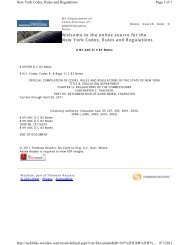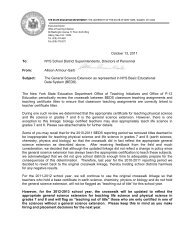ESL Learning Standards - Higher Ed - New York State Education ...
ESL Learning Standards - Higher Ed - New York State Education ...
ESL Learning Standards - Higher Ed - New York State Education ...
You also want an ePaper? Increase the reach of your titles
YUMPU automatically turns print PDFs into web optimized ePapers that Google loves.
Students learning English as a second language will use English for self-expression, artistic creation,<br />
and participation in popular culture. They will develop and use skills and strategies appropriate to<br />
their level of English proficiency to listen to, read, and respond to oral, written, and electronically<br />
produced texts and performances, relate texts and performances to their own lives and other<br />
works, and develop an understanding of the diverse social, historical, and cultural dimensions the<br />
texts and performances represent.<br />
Performance Indicators: See page 16<br />
Advanced<br />
Students complete Intermediate task. Students listen to a<br />
third fairy tale and compare it to the other two on a classdeveloped<br />
semantic feature analysis chart. Class discusses<br />
the similar features they observed within the fairy tale<br />
genre.<br />
Performance indicators: 1, 3, 7, 10, 12<br />
English Proficiency Level<br />
Transitional<br />
Students complete Advanced task. Students create their<br />
own fairy tale puppet and give descriptive information as<br />
to where it lives, its name, and its magical powers.<br />
Students present puppets to the class, describing their qualities<br />
and features.<br />
Performance indicators: 1, 3, 7, 8, 10, 12<br />
Students complete Intermediate task. Class changes one<br />
element of the story (e.g., “What if the boy doesn’t believe<br />
it will grow? What if the mother believes the boy?”).<br />
Students describe possible new story endings, decide on<br />
one, and dictate this ending to teacher.<br />
Performance indicators: 1, 2, 4, 5, 8, 9, 10<br />
Students complete Advanced task. Each pair of students<br />
draws a part of the new story, and copies text from new<br />
ending. Whole class compiles a new storybook.<br />
Performance indicators: 1, 2, 4, 5, 8, 9, 10<br />
Students complete Intermediate task. Class compiles illustrations<br />
of how parents care for them, and creates an accordion<br />
book with written descriptions or captions for each<br />
picture. Class discusses the similarities and differences<br />
between and among student responses.<br />
Performance indicators: 2, 5, 7, 8, 9<br />
Students complete Intermediate task. Each student creates<br />
an illustrated story of what would make their day “terrible,”<br />
following the model of Alexander and the Terrible,<br />
Horrible, No Good, Very Bad Day. Students share these stories<br />
with the class.<br />
Performance indicators: 1, 2, 6, 7, 8, 10, 11<br />
Students complete Advanced task. Students visit school<br />
library or peruse books brought to class by teacher and<br />
search for storybooks featuring baby animals. Referring to<br />
Three Little Ducks or Have You Seen My Duckling, students<br />
identify other ways baby animals are cared for. Teacher<br />
compiles list.<br />
Performance indicators: 2, 5, 7, 8, 9, 10<br />
Students complete Advanced task. In small groups, students<br />
create skit of a terrible day by using content from<br />
their individual stories created in the Advanced task. They<br />
include elements of character, plot, and setting. Skits are<br />
presented to their own class and/or another class.<br />
Performance indicators: 1, 2, 4, 6, 7, 8, 9, 10, 11<br />
<strong>ESL</strong><br />
2<br />
Pre-K<br />
– 1<br />
CLASSROOM<br />
TASKS<br />
Sample Classroom Tasks 35
















